A full-throttle tale of raw passions and gut emotions.
Although Clash by Night opens like a documentary and has certain characteristics of film noir, it is neither, though their absence is a poor excuse to avoid seeing this somewhat obscure film, well-acted, the script being its weakest part. It’s engaging enough to hold most viewers’ interest, even if the film’s end will leave a sense of surprise and disappointment.
On-location filming was becoming more frequent in the early ’50s, following, especially, the successes of The Naked City, shot in New York City, and John Huston’s The Treasure of the Sierra Madre, filmed partly in Mexico, both from 1948. The Clash by Night exteriors were filmed at sea, on beaches and docks at Monterey, California, the interiors in the RKO studios. This was post-1945 when Monterey’s fish canneries had been made famous in John Steinbeck’s Cannery Row.
For a movie that is essentially a love triangle with a romantic subplot as well, the music for the opening titles and introduction gives no such indication. Devoid of any romantic swooning or sinister tragedy, Roy Webb’s bright score is pure outdoors, with swirling strings, twittering flutes, crashing cymbals and soaring horns, matching the on-screen visuals of ocean waves crashing on shore. After the credits, the maritime-flavored music, with oboe and hushed strings, accompanies a calm sea, seals on a platform, terns and gulls and fishing boats.
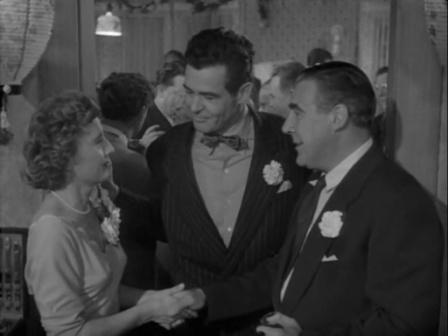 Aside from scoring a number of horror films, including The Cat People (1942), Webb, even more, was the film noir composer, with such masterpieces to his credit as The Spiral Staircase (1945), Out of the Past (1947) and The Window (1949).
Aside from scoring a number of horror films, including The Cat People (1942), Webb, even more, was the film noir composer, with such masterpieces to his credit as The Spiral Staircase (1945), Out of the Past (1947) and The Window (1949).
Although scenes of the sea will color all the film, the story that follows the picturesque opening is quite different. Now on screen are confrontational people engaged in arguments, deceptions and numerous personal games as well as adultery; they only rarely inhabit that effervescent outdoors, preferring to exist behind closed doors, in houses, bars and restaurants.
Misleading traits of film noir abound—frequent overtones of chiaroscuro and swinging lights that cast uneasy shadows—but because no one is a criminal, nobody is after illegal material gain and no one dies, Clash by Night is not technically a film noir. The characters simply inflict their wiles on each other, or share a few, sporadic joys, in the style of film noir.
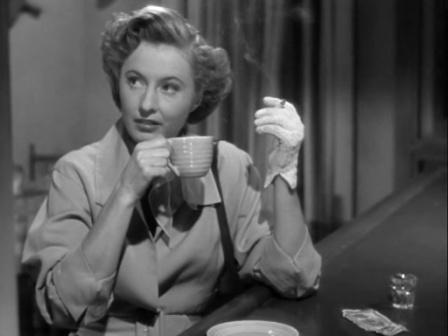 The actress central to the story, the character who is most consistently real despite the idiosyncrasy of the dual-authored script, is veteran Barbara Stanwyck. She brings out her character’s worldly hard edge, conveying her suppressed anger at what she has become. She suffers the knowledge that neither man in her life is a satisfactory companion or lover, neither the one she finally marries nor the other whose sexual advances at first frighten, then tempt her.
The actress central to the story, the character who is most consistently real despite the idiosyncrasy of the dual-authored script, is veteran Barbara Stanwyck. She brings out her character’s worldly hard edge, conveying her suppressed anger at what she has become. She suffers the knowledge that neither man in her life is a satisfactory companion or lover, neither the one she finally marries nor the other whose sexual advances at first frighten, then tempt her.
If Stanwyck is often caught between two men, then Paul Douglas seems caught between Stanwyck and her other man. He alternately likes and dislikes both her as a girlfriend/wife and him as a friend/rival. Douglas does a lot of shouting, which can sometimes be confused, both by actors and critics, with good acting—just how convincingly is the shouting? Peter O’Toole, for example, is quite competent as a shouter.
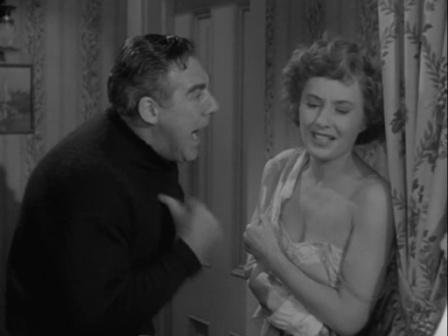 Here, however, Douglas, more of a big city actor, burly and blustery (where the shouting comes in), is at his best in lighter roles, clearly effective in A Letter to Three Wives (1949) and Executive Suite (1954). Less successful in Clash by Night, the complexities and nuances of his role are just a little bit beyond him, and the shouting is not a convincing substitute for the needed passion and anger.
Here, however, Douglas, more of a big city actor, burly and blustery (where the shouting comes in), is at his best in lighter roles, clearly effective in A Letter to Three Wives (1949) and Executive Suite (1954). Less successful in Clash by Night, the complexities and nuances of his role are just a little bit beyond him, and the shouting is not a convincing substitute for the needed passion and anger.
On the other hand, both in Clash by Night and in practically every movie he made, Robert Ryan is strong and intense, the qualities that Douglas lacks. While never a leading man, Ryan is always a dependable supporting player, usually in determined and—here’s that word again—intense roles, often as a man with a strict code, whether good or bad. In Clash by Night he is on the sleazy side, and easily portrays, almost naturally, a man who gleefully pursues Stanwyck regardless of her status, married or not. He might even be in this role, as one critic has called him, evil.
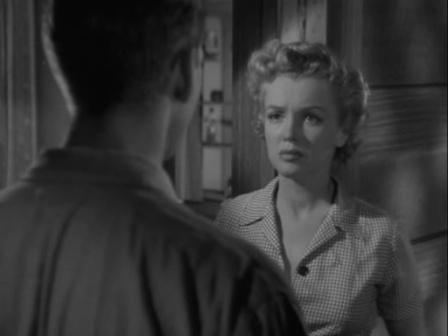 While Douglas was opposed, Stanwyck supported having Marilyn Monroe’s name above the title, and here, especially, she deserves it. Clash by Night offers her a larger and broader role than a crook’s moll in The Asphalt Jungle (1950), a true film noir, and a naïve actress in All About Eve (1950). She would reach fame and cement her status as a sex symbol in Gentlemen Prefer Blondes in 1953.
While Douglas was opposed, Stanwyck supported having Marilyn Monroe’s name above the title, and here, especially, she deserves it. Clash by Night offers her a larger and broader role than a crook’s moll in The Asphalt Jungle (1950), a true film noir, and a naïve actress in All About Eve (1950). She would reach fame and cement her status as a sex symbol in Gentlemen Prefer Blondes in 1953.
Even in Clash by Night, long before it became a trait and a great expense for the studios, Monroe’s inability to remember her lines was already a problem. It’s somewhat inexplicable, then, that she was able to pull off one especially long tracking shot, a walk beside her boyfriend, without flubbing a line—possibly after many takes.
Monroe is half of the film’s secondary romantic relationship—a somewhat hostile one, involving fistfights and sadistic towels around her neck—as the fun-loving girlfriend of so-called “newcomer” Keith Andes. He had made three previous films. Like Kirk Douglas, Burt Lancaster and, most recently, Matthew McConaughey, Andes is frequently seen shirtless in his films; certainly more so than his three fellow actors, his career rests on his beefcake attributes rather than on his acting.
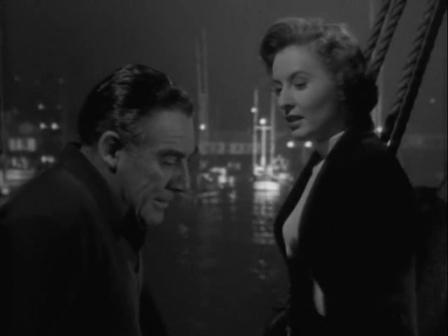 After some years on the East Coast, Mae Doyle (Stanwyck) returns to Monterey and the family home she had shared with her brother Joe (Andes), a fisherman. Joe is less enthusiastic about seeing her than his girlfriend Peggy (Monroe), who greets Mae affably. Peggy works on the processing line in the fish cannery.
After some years on the East Coast, Mae Doyle (Stanwyck) returns to Monterey and the family home she had shared with her brother Joe (Andes), a fisherman. Joe is less enthusiastic about seeing her than his girlfriend Peggy (Monroe), who greets Mae affably. Peggy works on the processing line in the fish cannery.
Soon, Mae begins seeing another fisherman, Jerry (Douglas), who owns his own boat and is Joe’s boss. It’s the consensus that Mae is after Jerry’s money. Jerry is easy-going but somewhat naïve. She is at first repelled by a sinister, woman-hating projectionist, Earl (Ryan), she meets at the local movie house; he’s married to a vaudevillian, away on tour.
Jerry is oblivious to the subtle change in Mae, who, along with her persistent repulsion, is also attracted to Earl. Perhaps as a deterrent to this fascination, she marries Jerry, although she’s not in love with him. She believes, maybe, besides the security, he will give stability to her loose-ended life.
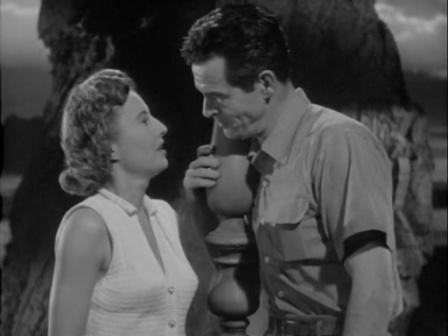 But Earl is persistent, seeing in Mae a reflection of his own cynical and restless nature; it doesn’t matter that they are both married. Despite having a baby with Jerry, Mae is more bored and restless than ever, and, with Earl now divorced, they begin an affair.
But Earl is persistent, seeing in Mae a reflection of his own cynical and restless nature; it doesn’t matter that they are both married. Despite having a baby with Jerry, Mae is more bored and restless than ever, and, with Earl now divorced, they begin an affair.
In a fight, taunted by Jerry’s uncle (J. Carrol Naish), Jerry almost chokes Earl until Mae intervenes. Earl persuades Mae to leave Jerry, and without the baby, but, after a brief time away, she returns. The act is too much a betrayal, even for Mae’s pitiful sense of responsibility, and she is finally able to convince Jerry to take her back.
The last shot of Clash by Night is of the sea.
The film, in many ways, is open-ended. A happy life for Mae and Jerry is not guaranteed. Because of their very natures, they could conceivably fail in making a success of their already precarious marriage. The general direction of most of the film had been Mae’s discontent with Jerry and her gradual submission to Earl—she certainly had been convincing—and then, in the story’s last scene, the film makes an abrupt about-face. A little implausible.
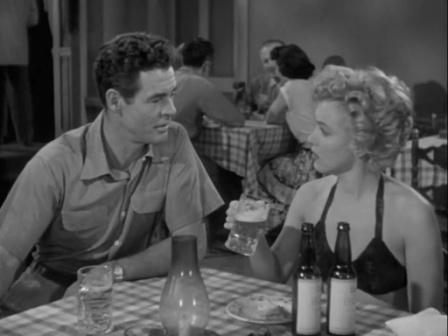 And it’s all because of the continuing influence of the Hollywood Production Code, this guardian of America’s morality, that Mae and Earl’s adultery must be punished—well, at least partly condemned in this case. In the late ’30s, say, Mae and Earl’s sentence would have been more severe, usually death: a fatal illness, a car accident. Now, though the Code was considerably weaker by 1952, the guilty cannot just walk off into the sunset, so Mae and Jerry had to remain married, and Earl sent packing.
And it’s all because of the continuing influence of the Hollywood Production Code, this guardian of America’s morality, that Mae and Earl’s adultery must be punished—well, at least partly condemned in this case. In the late ’30s, say, Mae and Earl’s sentence would have been more severe, usually death: a fatal illness, a car accident. Now, though the Code was considerably weaker by 1952, the guilty cannot just walk off into the sunset, so Mae and Jerry had to remain married, and Earl sent packing.
Those earlier mentioned “idiosyncrasies” of the dialogue come from Clifford Odets’ 1941 play of the same title and from Alfred Hayes’ screenplay. Between them—and Hayes has basically maintained the essence of Odets’ style—the characters render pseudo-intellectual platitudes that seem artificial and pretentious, often delivered in raised voices and in lightning-quick comebacks. Average people don’t think fast enough to invent such limitless punch lines.
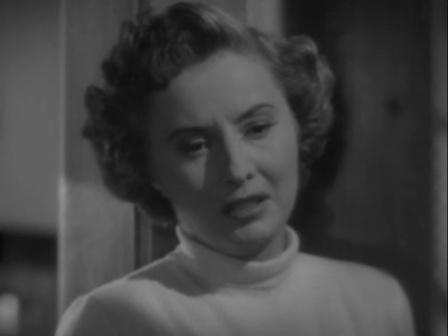 Speaking to Earl, Mae is saddled with “You impress me as a man who needs a new suit of clothes or a new love affair—and he doesn’t know which.” On the beach, Earl must say to Mae, “Don’t make me sorry for him [Jerry]. If I’m sorry for him I can’t be sorry for us, and we’ll both be sorry love was ever invented.” Nor does even Joe, the least “deep” of the group, escape such philosophizing. “The world—it ain’t big enough,” he says to Mae. “Your life—it ain’t interesting enough.”
Speaking to Earl, Mae is saddled with “You impress me as a man who needs a new suit of clothes or a new love affair—and he doesn’t know which.” On the beach, Earl must say to Mae, “Don’t make me sorry for him [Jerry]. If I’m sorry for him I can’t be sorry for us, and we’ll both be sorry love was ever invented.” Nor does even Joe, the least “deep” of the group, escape such philosophizing. “The world—it ain’t big enough,” he says to Mae. “Your life—it ain’t interesting enough.”
Five characters speak alike, in the same voice of two men, Odets and Hayes.
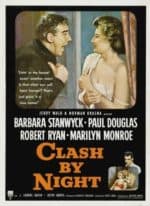
Enjoyed your review but was surprised to hear you say Robert Ryan was never a leading man. How about The Set Up,The Proud Ones,Act of Violence, Her Twelve Men, Caught, to name a few.
Clash by night is a time portal to californias sunny coast with 1950s morals and sociopathic
standards of woman versus man in a contest of whos the best looking and whose suited to who,
all is well till the towel of choking death rears its ugly jealous ranting choking scene. its an era of days gone by, that make Red Hot Chili Peppers Californication songs make sense. Well made film, well acted at times. Its a fun movie to watch around 11:00 at night to save on gas, to get to monterey, CA. Otto preminger did direct this movie and a river of no return. OOOPPS! i left my paddle in calgary canada. Dont go youll save money, on the “Clash on the river of no return” wailareeeee!!